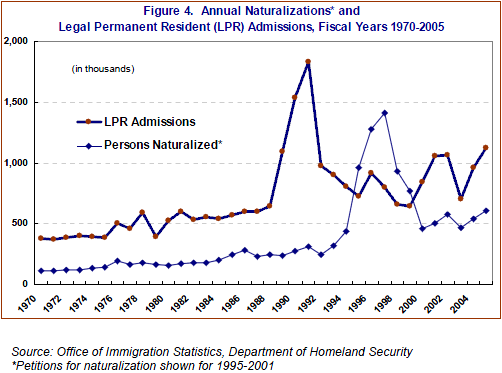The number of foreign-born residents who became U.S. citizens rose from an annual average of less than 150,000 throughout the 1970s to more than 650,000 since the mid-1990s. This growth reflects both an increase in the nation’s supply of legal immigrants and an increased likelihood that those who are eligible apply for citizenship.
After years of incremental, steady increases, the pace of naturalizations suddenly picked up in the early 1990s. The number of people who became citizens had risen by about 5% annually from 1970 through 1993 (Figure 4 and Appendix Table 1). But a new pattern emerged as many more immigrants began to file naturalization papers. The number of new citizens doubled—from 240,000 to 490,000—between 1992 and 1995. In 1996, for the first time, more than 1 million people took the oath of citizenship.
The number dropped after that, in part because of delays in processing applications, but began rising again. So far this decade, an average of about 630,000 people has become naturalized citizens each year.
Naturalizations Track Admissions
The number of foreign-born residents who become naturalized citizens in any given year generally tracks the number admitted six years earlier. [See box explaining citizenship eligibility.] The total can be affected by backlogs in the application system or changes in the processing of applications. It also depends on the share of legally admitted immigrants choosing to apply for citizenship.
In the late 1960s, about 345,000 people a year were admitted as legal immigrants. The average number of admissions rose by about 3% a year, reaching 600,000 by 1986. Admissions of legal permanent residents peaked temporarily during 1989–1992 , when more than 2.6 million formerly unauthorized immigrants obtained permanent residency under provisions of the Immigration Reform and Control Act of 1986 (IRCA). In addition, about 2.8 million immigrants were admitted as permanent residents under regular provisions of immigration law. As a result, more than 5.4 million people became legal permanent residents during those four years.
There were small surges in the number of naturalized citizens in 1986 and 1991 that roughly reflect increased admissions in 1978 and 1981. The rise in the number of naturalizations in 1996, to a peak of more than 1 million—more than double the total from the previous year—clearly reflects the impact of the peak admissions under IRCA.
Recent Trends
The number of citizenship applications increased to 1.4 million in 1997, a new high. Naturalizations declined from the previous year’s record, though they remained high. Changes that delayed the processing of applications contributed to the decrease. A large backlog of citizenship applications built up: About 1.8 million applications were pending in 1998, but the backlog settled down to about 600,000 in the first years of this decade. For 2005 and 2006, about 500,000 applications were pending each year.
The number of people admitted as legal permanent residents, which has bumped up and down since the early 1990s, exceeded 1 million in at least three years this decade. That suggests that the number of naturalizations, now about 600,000 to 700,000 a year, may increase slightly in the near future and reach a new plateau.
The data indicate that eligible immigrants increasingly are likely to apply for citizenship and naturalize. The number of legal permanent residents has gone up since 1970, as has the share becoming naturalized citizens.


